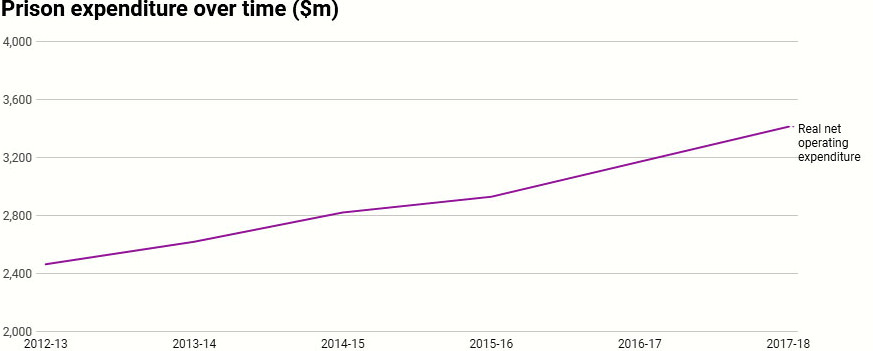Thinking Outside the Cell Defined Terms Baker's Dozen Problems Articles & Reports - Bibliography
With rising rates of imprisonment, CEDA Chief Economist Jarrod Ball explores the cost of recidivism to the Australian economy - CEDA - Jarrod Ball | 2 July 2019 | 2 Comments
The public’s focus on crime
statistics is often personal - what do crime rates suggest about personal safety
in my city or local neighbourhood? In many instances, there is an
overwhelmingly positive story to tell about recent trends in crime. For example,
a recent report from the Australian
Institute of Criminology puts the homicide rate at its lowest level in 25 years.
Despite this, a ‘tough on crime’ mantra has prevailed across state governments
and CEDA’s 2018 nation-wide poll, Community
Pulse, highlighted
that Australians place importance on
tough criminal laws and sentences. The flip side is that
we are placing increasing numbers of
people into a system that is not working to rehabilitate individuals and break
the cycle of offending.
Compared to a decade ago, Australia is
putting 51 more people into prisons for every 100,000 of our adult population,
reaching 221 for every 100,000 last year. This now places Australia around a
fifth higher than the OECD average for rates of imprisonment.

Even more concerning is that the most
rapid growth in prisoner numbers is for Indigenous people and women. Prisons are
also increasingly occupied by lower level offenders. For example, in Queensland
the median prison sentence is less than four months and 65 per cent are for
non-violent offences.
But most concerning of all is that at
least half of all prisoners in 2017-18 had been imprisoned as adults previously.
Without a greater focus on rehabilitation, the cost to society, both economic
and social, will continue to grow unchecked.
The human costs of increasing
imprisonment are devastating but often hidden from public sight. But the
economic costs are increasingly obvious, eating up taxpayer dollars, hitting
state budgets and impacting the productive potential of our economy.
According to the
Productivity
Commission, the annual cost of prisons in Australia reached over $4.6 billion in
2017-18, equating to $302 per prisoner per day.

Unsurprisingly, increasing rates of imprisonment are driving significant increases in the operating cost of prisons. In the five years to 2017-18, the operating cost of prisons increased in real terms at an annual rate of 6.7 per cent. This eclipses other rates of government spending growth over the period, including on General Practitioners (3.7 per cent) and early childhood education (5.1 per cent). It also outstrips expenditure growth in other parts of the justice system including police and courts.

If current trends continue, significant
new investment will be required. The Queensland Productivity Commission
estimates that in Queensland alone, $5.2 to $6.5 billion in new investment will
be required for prison capacity to meet demand in 2025. Victoria’s recent budget
included $1.8 billion of investment in new prison capacity.
This is a sizeable challenge for state and territory budgets at a time when they
are being squeezed by ballooning demand for services and increasingly narrow and
fragile tax bases to pay for those services.
The imperative for state and
territory governments must be to achieve better outcomes that meet community
expectations with the scarce resources available.
While the indirect costs of imprisonment
are less easily quantified, the lost potential for the economy is substantial.
In 2015, a survey by the Australian Institute of Health and Welfare (AIHW) found
that over a third of prisoners were in employment in the 30 days before
imprisonment, with another third either seeking employment or studying. This
translates into lost economic potential –research undertaken in Victoria by
Anthony Morgan for the Australian Institute of Criminology found that average
lost productivity for each prisoner there was over $16,000.
The impacts on the economy from imprisonment extend further, with costs incurred
through deteriorating physical and mental health of prisoners, and families of
prisoners relying on crisis and income support.
The Queensland
Productivity Commission has recently estimated that indirect costs for each
prisoner in Queensland are at least $40,000 a year.
These statistics are
alarming and underline growing need for change in the justice and corrections
systems. Last week Deakin University convened its 15th
Annual Reintegration conference,
an enduring
dialogue on how Australia re-thinks its criminal justice system. This year’s
conference focused on the services and supports needed for people who experience
stigma and discrimination after prison so that they can rebuild their lives.
This idea of re-thinking criminal
justice appears to be catching on and may yet revive some of the reformist zeal
in the federation. Some state governments are showing promising signs that they
will take steps to reverse recent trends. Next month the Queensland
Productivity Commission will deliver its final report to the government from its
12-month inquiry into imprisonment and recidivism, following a draft report that
suggested 18 improvements to the current system. In Victoria, the Corrections
Minister has signalled a review of the Corrections Act to address increasing
imprisonment and recidivism.
There is much more to be done, but the
economic numbers alone suggest that the case for substantial reform is
compelling across the federation.
CEDA touched on this issue in Connecting
people with progress and
will continue to look at this issue through our policy stack of five critical
areas of focus where Australia can drive better social, economic and
environmental outcomes. This is an area
where CEDA is prepared to take a positive role in facilitating collaboration and
discussion across the community.